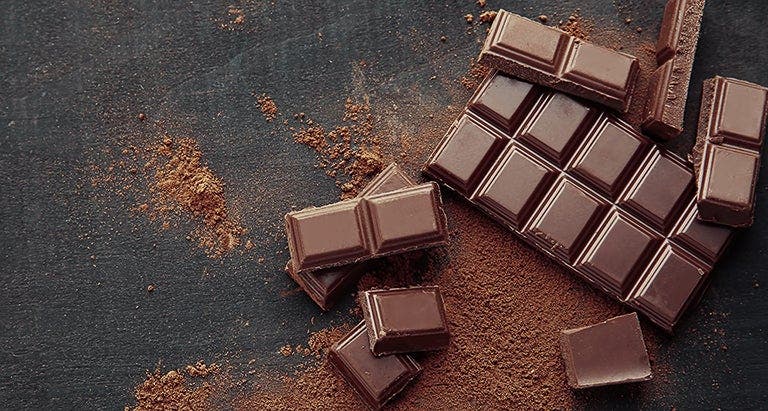How to Buy, Eat, and Cook with Chocolate


Beans to Bars
In order to understand the differences between types of chocolate, we first need to understand how it's made. All chocolate is made from the beans of the tropical Theobroma cacao tree cultivated in Mexico and Central and South America. In their natural unprocessed state, cacao beans are intensely bitter. To become chocolate as we know it, the beans are fermented, dried and roasted, then cracked open to extract the cacao nibs from the shells. The nibs are then ground into a cocoa mass, also known as chocolate liquor, which is pure chocolate in a rough form.
At this point, other ingredients (sugar, dairy products, vanilla and other flavorings, and lecithin, an emulsifier) may be added, and the chocolate gets its final processing —"conching"— in which large machines "knead" the chocolate mass (ridding it of moisture and volatile acids) and create a smooth texture. High-quality chocolates are conched for up to 72 hours, lesser-quality chocolates for just a few hours.
Health Benefits
Cocoa solids contain some of the same nutrients as dark leafy vegetables. Cocoa solids are rich in antioxidants and also contain fiber: A 38-gram serving of dark chocolate contains up to four grams of fiber! Despite these benefits, eating large quantities of chocolate isn't the same as munching on dark leafy greens.
Eaten in moderation, however, chocolate is a healthy way to indulge your sweet tooth. The trick is to use chocolates high in cocoa solids: dark, semisweet, and bittersweet. Expert chocolatier Jacques Torres (who has lost weight with WeightWatchers®) suggests sticking with high-end dark chocolates.
“Dark chocolates have less sugar and the most health benefits. You don’t need much to satisfy your desire because the flavor is very powerful," says Torres.
Buying
These days, large supermarkets and even drugstores carry a range of high-quality chocolates. Look for imports from countries such as France, Switzerland, England, Belgium and Mexico, as well as better domestic producers including Ghirardelli, Guittard and Scharffen Berger. To maximize health benefits, look for chocolates that are 65 to 75 percent cocoa (or cacao) content. Gourmet and specialty stores often carry rarer, artisan chocolates made by smaller producers. There are also mainstream (think Godiva) and small independent stores devoted to chocolate that sell their own confections, like truffles and candies covered with a glossy coating of couverture chocolate (high-quality chocolate with extra cocoa butter).
Storing
All chocolate should be tightly wrapped and stored in a cool dry place. When chocolate gets too warm it can develop a white or gray bloom (caused by cocoa butter rising to the surface; this happens more often with milk chocolate). Damp conditions can cause the formation of small sugar crystals. In both cases, chocolate is still fine for cooking and eating.
Cooking
Dark, bittersweet, and semisweet can be used interchangeably in recipes.
Cocoa powder
Many recipes call for unsweetened cocoa powder (sometimes called natural cocoa), which is simply ground cocoa solids with very little cocoa butter. Unsweetened cocoa powder is bitter with deep chocolate flavor, making it suitable for brownies and cakes. Dutch-processed (or alkalized) unsweetened cocoa powder is treated to neutralize its natural acids, giving it a milder, more delicate flavor. This process also reduces antioxidants in the cocoa, making it less healthy. The two types are not entirely interchangeable. Regular unsweetened cocoa powder is acidic, and when used in recipes that call for baking soda, it creates a leavening action that causes batter to rise. Dutch-processed unsweetened cocoa powder is pH neutral and will not react with baking soda, so it must be used in recipes with baking powder.
Chocolate chips
Always bittersweet unless labeled otherwise, they tend to be lower in quality, higher in sugar, and made with less cocoa butter so they retain their shape better and melt more slowly. When a recipe calls for chocolate chips, Torres recommends substituting hand-chopped dark or bittersweet chocolate.
Melting
Chocolate (especially milk and white) burns easily and should be melted slowly over low, gentle heat, either in a double boiler or a smaller pot placed within a larger pot of simmering water. Heat until chocolate is almost all melted, remove from heat and stir until completely melted. Another method is to use a microwave at half power for one-minute intervals, stirring often, until melted.
| Chocolate Choices |
|---|
| Unsweetened (aka chocolate liquor, baking, cooking or bitter): Chocolate liquor with no additional ingredients. Dark, bittersweet, semisweet: Firm in texture, these take a while to melt in your mouth, have an intense chocolate flavor and can have notes of cherries, coffee, caramel and beyond. Milk: Lighter in color than dark, bitter and semisweet, with a softer, creamier texture and more muted flavor. White: Contains cocoa butter and no cocoa solids — therefore has no real health benefits. Most chocolate connoisseurs do not consider it true chocolate. |
| Specialty Sweets |
|---|
| Single origin: Made from beans that come from one region (and sometimes even a single plantation). Similar to single varietal wine, coffee and olive oil, these have subtle, varying flavors that convey distinct “taste of place." Fancy flavors: Also in vogue are luxury bars enhanced with the likes of ginger, chipotle peppers and even bacon. They're more suitable for eating than for baking since flavor nuances might get lost in a sea of ingredients. Fair trade: If sustainability and labor practices (much of the world’s cacao beans are harvested by children) are important to you, organic and fair-trade chocolate is available. |
